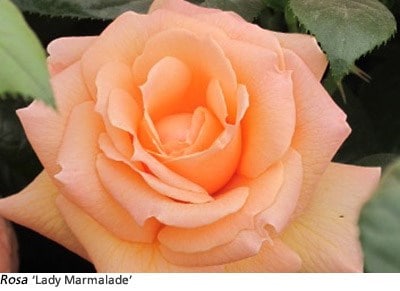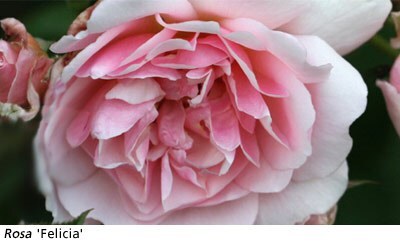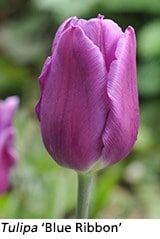Plant in Good Weather
The golden rule is to get them in when the weather allows. Do not plunge your new roses into icy soil. Order them now and prepare the ground and then cover it with either bubble wrap, cardboard, an old carpet or anything else that will prevent frost penetrating the ground. Then the hard work is done. If this is an impossibility and your roses happen to arrive in hard weather, bide your time and keep them against the house wall until the frost and cold retreat. They will not mind at all.
When planting look at your rose carefully and position it so that the three or four splaying stems can be seen to best advantage, because every plant has a front and back. The compost will probably fall away, so add it to your planting hole. Don’t be afraid to trim any stems, BUT always back to an outside-facing bud. You can also shorten any over-long roots if it makes planting easier. Never add manure when planting as it may scorch the roots. Garden compost can be used, but generally well-dug garden soil is fine. If you’re replacing a rose with another, it’s best to replace the exhausted soil before planting. John Innes no 3 compost is a good, easy solution.
Once and Only or Repeat-flowering?
Modern roses are generally bred to be repeat-flowering with a main flush in June, followed by further flowers throughout the season. These roses ration their flowers with five to six weeks between flushes, finishing with a late flourish in October, or even November. All repeat-flowering roses need deadheading regularly to encourage more bloom. They also need feeding, both before (in early spring) and after their first flush, to keep them healthy and floriferous - Vitax Q4 is good as it is easy to sprinkle on and long-lasting with lots of flower-boosting potash.
Once and only-flowering roses are glorious in June, before fading away for good. However their branches drip with masses of flower for two or three weeks, adding great glory to the summer garden. Every gardener should aspire to plant a few for this reason, but there is no point in deadheading or feeding them after flowering because their work is done for the year. Just feed them once a year in early spring, just as the roses begin to grow.

Rambling roses are nearly always once and only flowering, producing new growth from the base every year. Many are vigorous and capable of scrambling into a mature tree, or covering a building given five or so years. ‘Paul’s Himalayan Musk’ could be mistaken for apple blossom from a distance, with its soft-pink sprays of double rosettes rising above small sea-green leaves. It has a graceful habit of cascading downwards, so this musk-scented rose is an excellent addition. The double flowers last for four weeks at least, and this rose is expansive but not overwhelming. ‘Kiftsgate’ is the most rampant rambler of all, so be warned. This white rose will need space and lots of it.
The white ‘Rambling Rector’, often known as Shakespeare’s Musk, is less feisty. The cream-white, semi-double flowers age to white, above greyish green foliage that never shows any disease. Small hips follow for autumn colour. The growth is more rigid, but it will scale a tree, or cover a shed quite happily. ‘Wedding Day’ has lemon buds that produce single white flowers with lots of golden stamens. The flowers age and develop a pale-pink blush. Finally the blue-purple ‘Veilchenblau’ is glorious planted on light stone walls in a sunny position, where it will turn purple - a unique colour in rambling roses.
Planting Close to a Tree
When planting against a large tree, dig a hole about a metre away from the trunk and angle the rose towards the trunk. The tree must be mature and strong enough to take the weight of the rose. Or you can train the rose up to the crown of branches, using wooden supports. In this case the rose should be planted on the outer reaches of the tree's canopy. Allow it to scramble up the supports and then into your chosen tree. Keep all roses well-watered in their first growing season.
Ground Cover
It’s worth considering planting ramblers on a steep bank for ground cover, so that they tumble downwards as they do at Crathes Castle in Scotland. Or you may consider the low-growing Flower Carpet roses, which are good at covering rough ground and need little maintenance other than a yearly trim with a strimmer. This sounds harsh, but it works. ‘Flower Carpet Sunshine’ is a good choice, or plant the Country Series that include the white ‘Kent’, or the frilly pink ‘Surrey’. Flower Carpet and the Country Series are both grown in RHS Wisley’s new Rose Garden, so don’t dismiss them just because they’re low-growing ground cover. They’re prolific and strong, but gentle on the eye.
Climbing and ‘Pillar’ Roses
 Many climbing roses have over-large flowers on leggy stems, due to their old-fashioned Hybrid Tea blood. Their pliable stems are ideal for winding around a pillar before the new growth hardens, usually in October and November. This slows the sap and helps produce more flowers. The following two are exceptional ‘pillar roses’, not leggy monsters that need to be viewed from the bedroom window. ‘New Dawn’ (technically a repeat-flowering Rambler) is very healthy with perfectly-formed silver-pink flowers and neat, healthy foliage, while ‘Aloha’ has salmon-pink cabbage-like blooms that achieve perfection. ‘Aloha’ will never disappoint, so overcome the ugly Hawaiian name and plant it! A lot of David Austin roses can also be used as pillar roses too, including the buff-yellow ‘Graham Thomas’, the cream-white ‘Claire Austin’ and the glowing-pink ‘Gertrude Jekyll’. Many climbing roses have over-large flowers on leggy stems, due to their old-fashioned Hybrid Tea blood. Their pliable stems are ideal for winding around a pillar before the new growth hardens, usually in October and November. This slows the sap and helps produce more flowers. The following two are exceptional ‘pillar roses’, not leggy monsters that need to be viewed from the bedroom window. ‘New Dawn’ (technically a repeat-flowering Rambler) is very healthy with perfectly-formed silver-pink flowers and neat, healthy foliage, while ‘Aloha’ has salmon-pink cabbage-like blooms that achieve perfection. ‘Aloha’ will never disappoint, so overcome the ugly Hawaiian name and plant it! A lot of David Austin roses can also be used as pillar roses too, including the buff-yellow ‘Graham Thomas’, the cream-white ‘Claire Austin’ and the glowing-pink ‘Gertrude Jekyll’.
You can also defy gravity (another way of slowing sap flow and getting more flowers), by pulling rose stems downwards, or by looping ramblers along the fence to produce arching shapes rather like a looper caterpillar in motion.
There are some repeat-flowering ramblers, but they tend to be shorter and less vigorous. ‘Phyllis Bide’ bears small salmon-pink flowers, but she’s thorny so position her carefully away from paths. Less thorny and with more apricot than pink flowers is the lovely 'Ghislaine de Féligonde', a rose with very glossy foliage that deserves to be grown more widely. This small rambler can be grown as a shrub as well and it will tolerate a north-facing position.
If something more vigorous is needed for a north-facing position follow Vita Sackville-West’s advice and plant the versatile Noisette rose 'Madame Alfred Carrière'. It’s in many rose buffs ‘Top Ten’ and can be grown anywhere. The foliage is shiny and healthy, the easily-trained stems are smooth and thornless, and the blush-white roses begin in June and linger on towards Christmas.
Finally ‘Gloire de Dijon’ has to get a mention as it can be a joy with its really fragrant, heavy-headed flowers that hover between buff-yellow, apricot and salmon-pink. The circular blooms swirl like whipped fondant icing enclosed by a cup-like sweep of outer petals. Its main flush is in June, with a few now and again afterwards, and the scent is heavenly.
Shrubby and Healthy
Lots of roses escape black spot (Diplocarpon rosae) and they include Rugosa roses bred from a shrubby Japanese species found naturally on poor, sandy soil. These thrive in most gardens, although lime-rich soil will produce yellow, chlorotic foliage. One of the finest, ‘Roseraie de L'Haÿ’ (1901) was named after a notable French rose garden of the same name. The serrated foliage is a rich-green, darker than most Rugosa, and the almost double purple-pink flowers appear from May onwards, but don’t expect many hips. The semi-double white, ‘Blanche Double de Coubert’, makes an excellent hedge but again there are few red hips. Light pruning in spring is best, because Rugosas tend to get some dieback following cold winters. Shrub roses and English roses are never pruned hard (see Tip 2).
David Austin’s ‘Wildeve’ is a strong, healthy rose with beautifully formed pink flowers that develop an apricot tint. It will make a metre wide and high roundel, but should be placed in a sheltered site because the long wands of growth can snap in summer gales. It can be accommodated in mixed planting, with Paeonia lactiflora varieties. Roses and peonies, which can also be planted now, are a marriage made in heaven. Paeonia ‘Festiva Maxima’ has cream flowers flecked in rose-red and Paeonia ‘Karl Rosenfield’ has fragrant magenta flowers in quantity, with excellent foliage.
Rosa ‘Princess Anne’, launched at The Chelsea Flower Show in 2010 by David Austin, has already gained an AGM, for vigour and beauty. The pink flowers open from cupped buds to a deep pink, before fading slightly - and the flowers keep coming. ‘Princess Anne’ is healthy, with an upright stance and a strong constitution - rather like the lady herself. This rose is bred from a new breeding line and significantly different from other pink roses because the flowers are formed with lots of almost oblong petals.

Health and vigour are a quality also found in the Reverend Pemberton’s Hybrid Musks. These roses, bred between 1924 and 1939, are garden classics and they flower well in July and then again in late-summer and autumn. They are all fragrant and healthy. ‘Felicia’ (1928) is perhaps the finest with clusters of dark-pink buds that open to form frilly salmon-pink flowers - perfectly formed and petite. This rose, hardly ever out of flower, is a shrub of upright habit. The classic ‘Buff Beauty’ (1939 ) is out of the same Pemberton stable, but more billowing in profile. It was introduced by Ann Bentall, the widow of Joseph Pemberton’s head gardener. Large trusses of warm-apricot flowers age to sunset-pink against reddish foliage. ‘Buff Beauty’ adores a warm position and it takes a few years to get established - but when it does it’s a show-stopper.
The Hybrid Musks are also trouble-free when it comes to disease and they are tolerant of poorer soil too, possibly because they were bred in the relatively dry county of Essex. ‘Bonica’, another superb rose for poorer soil, was raised in France by Meilland in 1982. The clusters of bright-pink flowers glow in a border and it’s low-growing and compact, bearing between a dozen to fifteen flowers per cluster throughout summer. This is one rose worth planting en masse, because it’s rarely out of flower so your garden can be full of roses from June onwards. You can make it happen now, by planting in November. |
Five Tips for November
 |
Plant Partners for Your Roses

Hide the ugly legs on your roses with perennials that enhance the roses and fill in the quieter gaps. Good compact companions to weave through the legs are Viola cornuta ‘Alba’, the white-edged bright-pink Geranium ‘Elke’, the blue ‘Philippe Vapelle’ and the lilac-pink, magenta-veined ‘Storm Chaser’.
Larger roses are good grown with Campanula lactiflora ‘Pritchard’s Variety’, a summer-flowering, metre-high rich blue campanula. Cut it back by a third in May to delay the flowers, ensuring they follow the roses. Phlox can be treated in the same way and Phlox paniculata ‘Blue Paradise‘ is good with orange-toned roses such as ‘The Lark Ascending‘ and the Rose of the Year 2014 - ‘Lady Marmalade’.
|
 |
Invest in Felco Secateurs (and Prune Roses in Winter)

Prune roses after the leaves have fallen, using Felco no 2 secateurs. Although they sound expensive, they will last a lifetime, making clean cuts. Christmas is coming so put them on your list, or buy them for a loved one.
Start by removing the 3Ds - any dead, dying or diseased wood on all roses. Hybrid Teas are pruned hard, back to 30 cm or less. Floribundas are treated more leniently, being cut back to 45cm. Shrub roses, Hybrid Musks and English roses (the modern shrub roses) should be treated very leniently indeed. Cut back one third of the leading shoots only and cut away any crossing branches, aiming for an open shape.
|
 |
Time to Order your Seeds

Think about next year now, while this year is still fresh in your mind. Many seeds can still be sown now, and this will produce stronger plants that tend to flower earlier in the season than those sown in spring. Store your seeds somewhere cool, in the shed or in the garage, in mice-proof tins. Our seed storage boxes are ideal, with flip top lids that allow you to see the name of the variety easily. If you add some packets of seeds they will make ideal Christmas presents for the green-fingered.
|
 |
Still Time to Plant Tulips

It’s best to plant tulip bulbs towards the end of autumn, so if you have not already done so, now is the time.
|
 |
Scrumptious Apples

This is also an excellent time to plant fruit trees and bushes. Apple ‘Scrumptious’ is perfect for small garden with red-fleshed apples that would tempt any Snow White. Eat them straight from the tree in September, for maximum sweetness and crunch. |
|
















